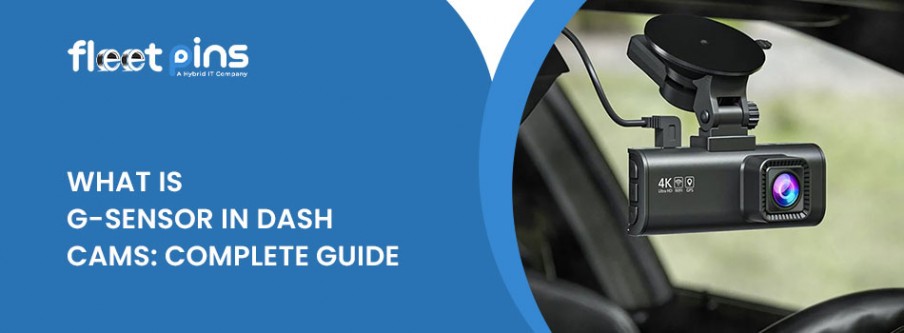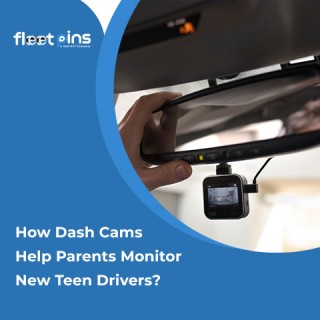
- On 2024-10-18
What is a G-Sensor in Dash Cams? Complete Guide
Dash cams have become an essential safety tool for drivers, providing video evidence in case of accidents and other incidents on the road. One important feature that sets some dash cams apart is the G-sensor. Fleet Pins will explain what a G-sensor is, how it works in dash cams, and why it's a useful feature for vehicle owners. By the end of this guide, you'll understand the importance of the G-sensor and how it enhances the functionality of dash cams.
What is a G-Sensor?
A G-sensor, or an accelerometer, is a built-in component in dash cams. G-Sensor detects sudden changes in motion, such as rapid acceleration, hard braking, or impact from a collision. The "G" stands for "gravity," and the sensor measures the forces of acceleration or deceleration that occur during such events. When a significant change in motion is detected, the G-sensor automatically triggers the dash cam to save the footage surrounding the event.
How Does a G-Sensor Work in Dash Cams?
The G-sensor operates by monitoring the movement of the vehicle. It continuously measures the force acting on the vehicle in three different axes:
- X-axis (front and back)
- Y-axis (left and right)
- Z-axis (up and down)
When the G-sensor detects a significant force along any of these axes, it triggers the dash cam to take specific actions, usually:
- Locking the recorded footage to prevent it from being overwritten by new recordings.
- Marking the file as an emergency recording makes it easy to find when reviewing footage.
For example, if a car is hit from the rear, the G-sensor will detect the sudden impact and save a few seconds of video footage. This video will be taken before and after the collision, ensuring that you have evidence of what happened.
You May Also Read: Types of Dash Cams for Fleet Use
Why is a G-Sensor Important in Dash Cams?
The G-sensor is key in making dash cams more effective for safety and legal purposes. Here’s why it is an important feature:
- Accident Documentation: In the event of an accident, the G-sensor automatically saves the footage, which can be crucial for insurance claims or legal cases. It ensures that important video evidence is retained even if the driver forgets to save it manually.
- Preventing Overwriting of Important Files: Dash cams continuously record old footage in a loop. The G-sensor ensures that footage involving sudden impacts is not deleted, helping drivers retain key evidence.
- Parking Surveillance: Many dash cams with a G-sensor can also detect impacts while the car is parked. If someone hits the car while it is unattended, the dash cam starts recording and saving the footage, providing details on what happened.
You May Also Read: How A Dash Cam Can Protect You in A Car Accident Claim
Features of a G-Sensor in Dash Cams
Most dash cams allow users to adjust the sensitivity of the G-sensor. This determines how easily the dash cam detects and responds to sudden movements. There are typically three levels of sensitivity:
- High Sensitivity: The dash cam will detect even slight movements or small bumps. This setting is useful for parking mode or areas with a high risk of minor impacts.
- Medium Sensitivity: Balances sensitivity to detect moderate impacts without triggering false alerts. This is usually the default setting.
- Low Sensitivity: Suitable for smoother driving conditions where only major impacts should trigger the G-sensor.
Event File Locking
When the G-sensor is triggered, the dash cam will save the recorded footage as a "locked" file. This means that it won’t be overwritten during continuous loop recording. Event file locking ensures that important footage remains available for review, even if the dash cam continues recording for a long period.
Parking Mode Activation
A G-sensor can also be part of a dash cam's parking mode feature. When the vehicle is parked, and the dash cam detects an impact, it will start recording, even if the camera is in standby mode. This helps capture incidents such as hit-and-runs or vandalism while the vehicle is unattended.
Benefits of Using a Dash Cam with G-Sensor
Dash cams with G-sensors automatically record and save video footage of accidents. This footage can serve as evidence to support insurance claims, protect you against fraudulent claims, or help identify the responsible party in a hit-and-run situation.
The G-sensor helps detect collisions while the vehicle is parked, allowing the dash cam to record any activity that might cause damage to your vehicle. This can help identify vandals or hit-and-run drivers.
Without a G-sensor, dash cams may overwrite crucial footage during continuous recording. A G-sensor prevents this by marking certain files as important, ensuring that they remain accessible.
Limitations of G-Sensors in Dash Cams
While G-sensors offer many advantages, there are some limitations to consider:
- False Alarms: If the sensitivity is too high, the dash cam may lock files during normal driving, such as when driving over bumps or potholes. Adjusting the sensitivity can help reduce false alerts.
- Battery Drain in Parking Mode: If the dash cam is powered by the car battery and remains active in parking mode, frequent activation due to the G-sensor may drain the car battery. Some dash cams have built-in battery management features to address this issue.
Tips for Using G-Sensors in Dash Cams
To make the most out of a G-sensor-equipped dash cam, consider the following tips:
- Adjust Sensitivity Settings Appropriately
- Regularly Review Locked Files
- Use a Dash Cam with Good Parking Mode Features
How Much Does a Dash Cam with a G-Sensor Cost?
The cost of dash cams with G-sensor functionality can vary widely, depending on features and quality. Basic models with standard G-sensor capabilities cost around $50 to $100, providing essential functions like event recording and file locking. Mid-range dash cams, which may include additional features such as higher video quality, GPS tracking, or enhanced parking mode, typically cost between $100 and $200. High-end dash cams with advanced features like 4K resolution, cloud storage, multiple cameras (front and rear), and more sophisticated parking monitoring can cost $200 or more.
Why Choose Fleet Pins for Dash Cam Installation?
Selecting the right dash cams with G-sensor features for your fleet is crucial to maximizing their benefits. When choosing dashcams, consider factors such as video quality, storage capacity, ease of installation, and additional features like GPS tracking and real-time alerts.
Choosing a reputable supplier that offers reliable customer support and warranty options is important.
Fleet Pins offers an AI Stand-Alone Safetycam that enhances driver and fleet safety with input from fleet managers. Fleet Pins' GPS HD SafetyCam integrates solutions to reduce risk, coach drivers, and improve safety.




